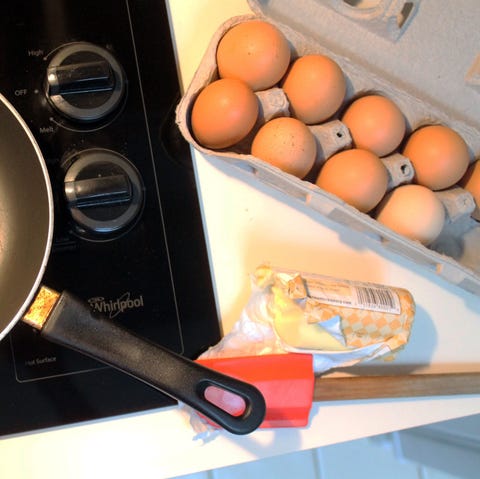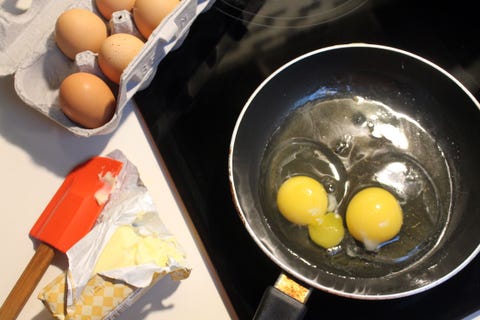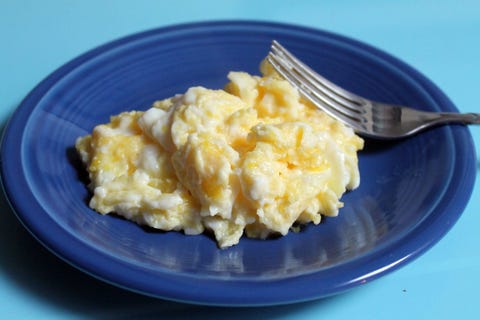
I’ve eaten at least two eggs almost every day of my adult life. Eggs are good for you. They’re high in protein, low in calories, and contain a host of essential vitamins and minerals.
I’ve eaten eggs many different ways, but I usually eat them scrambled. Poached eggs are wonderful, but making them undercaffeinated is a terrible way to wake up. Over-easy eggs are also good, but sometimes you will break a yolk and then ultimately you will make scrambled eggs, which is also why I usually eat scrambled eggs.
I’ve cooked scrambled eggs many different ways—both in adapting chef recipes for Men’s Health and experimenting for my cookbook, A Man, A Pan, A Plan. What I’ve come to understand is the there’s only one right way to cook scrambled eggs.
Fortunately, it is also very simple. You hardly even need any caffeine to do it.
Step 1: Use good eggs.
This is important.

Paul Kita
Generic supermarket eggs, as my grandmother says, have no taste. Farm-fresh (or at least farmers’-market-fresh) eggs taste, well, like eggs. They are bright, clean, and substantive. The yolks sit high and have a tinge of carrot-orange to their yellow. They resemble the morning sun.
Step 2: Use great butter.
This is very important.

Generic supermarket butter, as my grandmother also says, fucking sucks. Higher-end butter (and I’m only talking a buck or so more here, cost-wise) tastes rich and creamy. It possesses a certain heartiness. The color is a deep yellow, like an ear of summer corn. It resembles good eggs.
Step 3: Turn the heat down.
Most diners don’t cook eggs well. That’s because the short-order cooks are blasting all the food over a high-heat griddle. That means you get your eggs fast, but they’re often as dry as the paper placemat.
I could go all science-y here and explain how egg proteins coagulate, but the big reason you should use medium-low heat is because it’s harder to screw up your eggs that way.
Scrambled eggs can quickly move from uncooked to that weird wet dog smell off-gased by overcooking. You can minimize your risk of wet dog eggs by a gentler approach and a closer eye.
Step 4: Don’t beat it.
HERE WE GO INTERNET.
I don’t beat my eggs separately in a bowl. It’s a waste of time. It’s a waste of a bowl and a whisk and minute of your morning.
I add a thumb-sized amount of butter to a small non-stick pan, allow it to melt, swirling to coat, and then just crack the eggs into the pan.

Paul Kita
Then I don’t do anything until I begin to see the egg whites begin to cook. At this point, I take my spatula (I prefer rubber, but whatever) and stir the eggs. I will continue to stir the eggs not continuously, but frequently.
Step 5: Don’t add anything.
People do weird things to scrambled eggs as they cook. They add cream. They add salt. For some reason they add pepper or chives. Stop all that.
Amazing scrambled eggs do not require any additional ingredients in order for them to taste better, turn out fluffier, or become moister.
After you’re done scrambling the eggs, you can candy them in ketchup or smother them in hot sauce for all I care, but during the cooking process don’t fuss with them.
Step 6: Power down and plate.
The last minute of egg scrambling, I’d argue, is the most important.
How you will know you’ve entered the last minute: Your eggs will begin to resemble the consistency of folded satin. There will be the appearance of solids forming, yet the eggs will still look smooth.
During this last minute, turn off the burner and allow the residual heat of the burner and pan to coax the eggs to doneness. Continue to stir, more frequently now, until the eggs pillow. They should glisten.

Paul Kita
Now, gently transfer them to a plate.
And marvel.
Source: Read Full Article